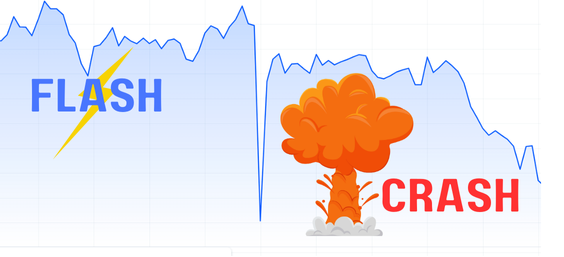Flash Crash in Trading
- valeriovisionfacto
- Jun 18, 2024
- 4 min read
Updated: Jul 26, 2024
Author: Doumkou Stefani
Publication date: 18.06.2024
This post may contain affiliate links, which means I may receive a small commission, at no cost to you, if you make a purchase through a link.
In the world of trading, the term "flash crash" often pops up, especially among day traders and those engaged in high-frequency trading. This term generally refers to the swift and significant drop in the value of a stock, often driven by reactionary trading or sudden market shifts, rather than fundamental changes in the company’s value. In this article, we will delve into this phenomenon in detail, addressing some key questions to better understand it.
What are Flash Crashes?
"Flash Crash" occurs when the price of a stock quickly drops, usually as a result of mass selling triggered by panic, rumors, or algorithmic trading responses to market news. We talk about a sharp decline which often does not reflect the underlying value of the stock and may recover just as quickly. It is a phenomenon that can create both risks and opportunities for traders.
Why do They Occur?
Flash crashes occur due to a combination of factors that disrupt normal market operations. Firstly, high-frequency trading (HFT) and automated algorithms can trade very fast. If they all react the same way or misunderstand data, they can cause big price swings. This problem gets worse when there aren't many buyers or sellers (low market liquidity), especially during volatile times, because even small trades can change prices a lot. Moreover, aggressive automated trading strategies might place very large orders that the market can't handle, leading to sudden price changes. Additionally, regulatory gaps and unexpected news, like economic or geopolitical events, can also trigger rapid market reactions. Lastly, technical or operational errors, such as incorrect trade orders, contribute to these dramatic events. All these factors together create the perfect storm for sudden and severe market disruptions.
A Case Study of the 2022 European Flash Crash
On May 2, 2022, a significant error by a trader at Citigroup in London led to a major disruption in the European stock markets, known as a flash crash. Citigroup trader accidentally placed a very large sell order on a group of European stocks. This large sell order caused computer programs and other traders to automatically start selling their shares too. They did this because the sudden increase in available shares made it look like something was wrong, or that the shares might lose value, so everyone tried to sell quickly. All this selling caused the prices of these stocks to drop very quickly and sharply. This severe drop affected many stock markets across Europe, not just a few. The drop was so sudden and extreme that trading had to be temporarily stopped. This was done to prevent further chaos and give time to understand what was happening. The incident resulted in significant financial losses for investors, created a liquidity crisis, and further damaged Citigroup's already precarious financial and reputational standing.
Other Historical Flash Crashes
2010 Flash Crash: U.S. stock markets dropped nearly 9% in minutes due to high-frequency trading.
2013 Hack Crash: A false tweet about an explosion at the White House caused the S&P 500 to drop sharply.
2015 Swiss Franc Shock: In January 2015, the Swiss National Bank abruptly ended the cap on the Swiss Franc, causing a rapid 30% surge and significant market turmoil.
2016 British Pound Flash Crash: The pound dropped 6% against the dollar during Asian trading, recovering quickly.
2017 Ethereum Flash Crash: Ethereum prices plummeted from over $300 to 10 cents on one exchange after a large sell order.
2019 Japanese Yen Flash Crash: The yen surged 3% in minutes during a Japanese holiday.
2020 U.S. Treasury Flash Crash: Treasury yields plummeted, marking the sharpest one-day drop since 2009, amid COVID-19 fears and oil price wars.
2021 Silver Flash Crash: Silver prices fell 6% overnight but rebounded fast.
Are Flash Crashes Common?
While it might seem that flash crashes are common due to the annual instances we listed above, they are actually quite rare when considered in the context of the millions of transactions that occur daily across global financial markets. However, when they do happen, flash crashes attract significant attention due to their dramatic nature and the rapid and often large-scale impacts they have on markets.
Strategies to Handle Flash Crash
To reduce the impact of a flash crash on your investments, you can:
Diversify: Spread your investments across different assets.
Use Stop-Loss Orders: Set automatic sell orders to limit losses.
Avoid Risky Strategies: Stay away from high-frequency trading.
Think Long-Term: Focus on long-term gains rather than reacting to short-term losses.
Stay Informed: Keep up with financial news and market trends.
Limit Leverage: Be cautious with borrowing to invest.
Keep Some Cash: Have liquidity to manage emergencies without selling other investments.
Seek Advice: Consider consulting with financial experts.
Mindful Trader: Enhance Your Trading Skills
If you're eager to improve your trading strategies and decision-making, Mindful Trader offers comprehensive educational resources, proven strategies, and essential tools. Ideal for both novice and experienced traders, Mindful Trader provides the support needed to navigate financial markets successfully.
Click here and join Mindful Trader today to unlock your trading potential for greater success!
Conclusion
The flash crash is much like a typhoon or tornado—it strikes suddenly, impacts forcefully, and fades swiftly, often leaving the market in shock. While it usually results in more losers than winners, some traders still find investment opportunities and manage to profit. Nevertheless, historical events often send shockwaves through the market, underscoring the importance of having strategies in place to manage sudden downturns.
You can also read about:






Comments